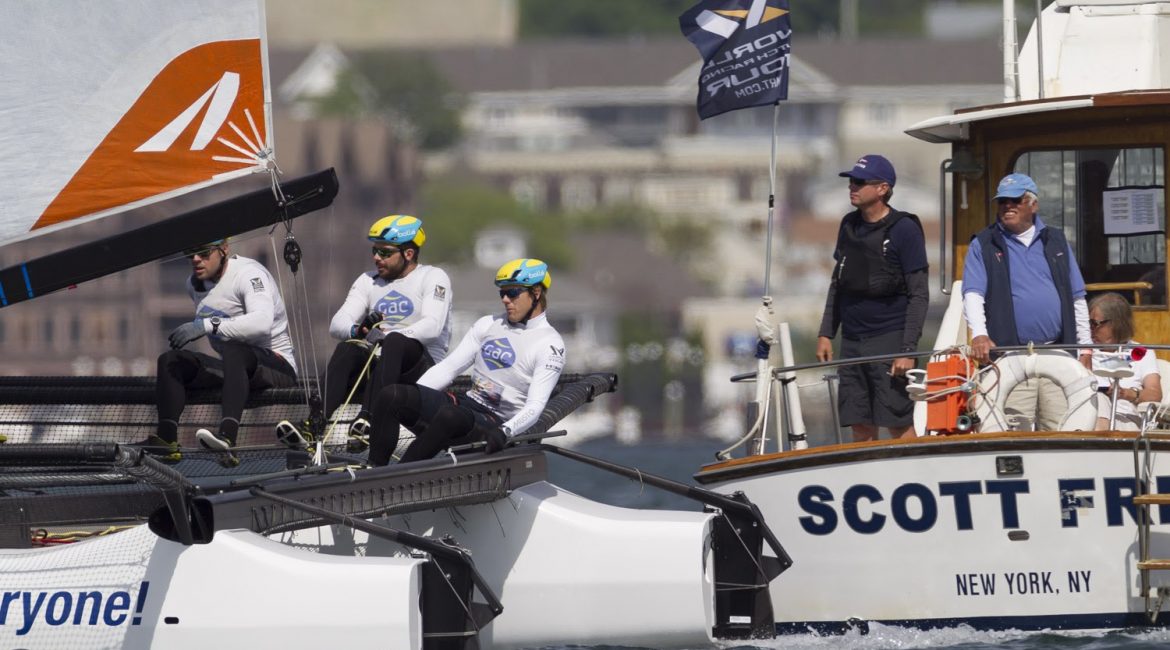It may only have two sails and appear one of the simplest race boats afloat, but rather like the Laser dinghy, there are all manner of nuances to the M32 catamaran, the understanding of which can mean the difference between winning and losing. Add to this a new format for the World Match Racing Tour, with regattas kicking off with two days of fleet racing and a new course format with reaching starts and course boundaries and you have something close to a new sport compared to the old look Tour.
In addition to his six Match Racing World Championship wins, Ian Williams has done the hard yards getting to grips with catamarans on the Extreme Sailing Series. So a year on since his GAC Pindar team acquired an M32, how is the British skipper getting on?
“I think everyone has a long way to go,” confides Williams. “The techniques – you can see them changing with every regatta we go to and that’s people learning off each other and independently. So it is definitely advancing. For every two knot change in wind speed, there is a slightly different technique, so you see some people look really good in a certain conditions, then you watch them the next day and they don’t seem to have it any more. Everyone has got their sweet spots, so what we are working on is to be consistently good over the entire wind range.”
So what sorts of things? “It is the rate of turns through tacks and gybes, the timings of cutting gennakers, furls, sheeting on, speed of sheeting on, how much do you prioritise getting weight forward versus getting the sails in: It’s those sorts of things that everyone’s working on.”
Then there’s crew weight distribution both laterally (flying a hull is fast and in some conditions weight to leeward is vital to pop the weather hull out) and fore and aft. Williams explains: “In almost all conditions weight forward is faster, but certainly if there is any breeze you can’t sacrifice a couple of guys to sit on the bow, because you need to get the gennaker on. So it is the balance between those things.”
And then there’s the course: “It is very different to what we’ve been sailing previously,” says Williams. “There are still wind shifts and gusts and still if you are in the right side of those you go faster than the other guy, but multihulls are harder to manoeuvre and it is harder to cover somebody and as a consequence you tend to get more splits and leads, but also greater opportunities to extend or to pass.”
Of greater consequence, Williams maintains, are the course boundaries, that chop off the side corners of the usual diamond-shaped windward-leeward course. However according to Williams how these courses are set remains a work in progress: “It may look like windward-leewards with top and bottom gates, but the boundaries impact it a lot and the organisers are still playing with different-sized boundaries. In Perth you could do two tacks to the top mark, in Copenhagen it was five or six and here [Newport] it is three or four. And that really changes the game, so it is hard to develop any strong rules about what you do in different situations because the game is slightly different. So the new course has really impacted the racing, hopefully in a positive way.”
For Williams, moving to the new look World Match Racing Tour has also required a change of crew profiles and skill sets. For example on board with GAC Pindar this year is the hugely experienced British former Tornado Olympian and multihull sailor, Mark Bulkeley.
In addition to experience, vital is the crew being as strong as possible. “The mainsheet and traveler are both pretty loaded….apparently! It certainly looks hard at times!” says Williams. However crew weight, and whether or not they should be as heavy as possible, is less obvious.
As Williams describes it: “Catamarans are very binary. If both hulls are in the water, you are faster if you are lighter. But if the weather hull is flying and the weight is all on the high side, you will be faster if you have more weight. So it is completely conditions-dependent.”
It also seems to be attracting new people, including some heavy hitters such as Spanish double Olympic medallist and round the world sailor Iker Martinez. There is obviously the attraction of the new catamaran, not to mention the $1 million USD prize money for winning next month’s event in Marstrand, but Williams also observes: “Previously the skill and experience levels were very high on the WMRT, so that was a barrier. If you wanted to win the WMRT you needed to spend two or three years of very hard graft to get to the required level. But now we are all beginners again, so people who haven’t match raced traditionally can give it a stab.”
So is he enjoying the new look WMRT? “I love new challenges and learning things and while you are learning and improving it is definitely enjoyable. I think it looks good. It is exciting to watch – and that has got to be a positive thing for our sport.”
